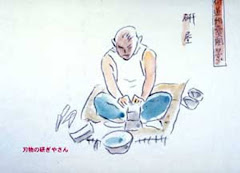Whatever the case may be you will probably tackle the job pretty much the same way, you'll select your base substrate and get to gluing.
Below I put together a quick & dirty tutorial on a couple of things that I found to be helpful tips to success when attaching a sharpening stone to a base.
The first thing to consider is the base material to be used. I'm old school & prefer wood like cypress as this is traditional. While wood is OK for non-soaking stones you might be better served with something a bit more stable for stone requiring some extended stay in the pond before use. Maybe something like granite, marble, glass, tile (etc) would lend themselves to the task of long soaks better than wood.
In the below tutorial I'm showing a natural stone that has come loose from it's factory mounted base & needs to get some repair time on the bench. In this case we have an uneven natural stone bottom and hunks of epoxy to deal with.

This part is important - selecting the correct epoxy. I can tell you from experience that water resistant does not equal water proof in the world of epoxy. I suggest going with a waterproof epoxy since you'll be using these stones in water....duh! I used System Three's T-88 because that's what I have the most of on hand but you don't need to special order such expensive epoxy just for this task, head on over to your hardware store and grab some Devcon 2-Ton - that's waterproof - and it's cheap and easily found.
Now it's done and after the required cure time the stone will be back in service.













